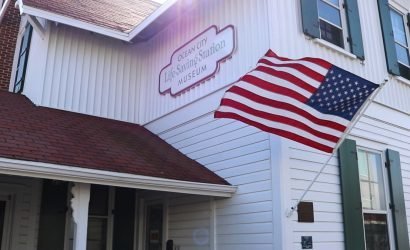The reputation of the Eastern Shore is one synonymous with natural beauty—endless bodies of glistening water, miles of coastline, beautiful sunrises and sunsets—all offering daily reminders to those of us who live here, just how lucky we are. Aside from all that beauty, the Eastern Shore boasts something else just as vibrant… a history dating back centuries, that some might say, is very much alive.
Before the Pilgrims set foot on Plymouth Rock, Captain John Smith explored the Chesapeake Bay in 1608, traversing the Nanticoke River. Before that, in 1524, Giovanni da Verrazzano is said to have sailed into the Chincoteague Bay and explored Assateague Island. The bridge connecting rt.611 with the barrier island bears his name. And long before European explorers reached these shores, Native American tribes inhabited this same land for thousands of years.
Modern-day Eastern Shore towns also have roots dating back centuries. Berlin, MD sits on land that was once part of a 1677 300-acre land grant. The Town of Snow Hill was established in 1686 and was involved in the Revolutionary War, the War of 1812, and the Civil War. While all this history is fascinating, there’s another element to it, an otherworldly one especially enticing at this time of year.
When there’s this much history there are inevitable stories passed down through generations. If these stories deviate from factual record, much like with the childhood game of telephone, what was said or actually happened in the beginning may very greatly from the end version. It’s these tales passed down through time that provide justification for the presence of spirits, ghosts, and other things that go bump in the night.
Those who believe that spirits live among us, in the shadows just past where we can readily see, often site these stories as the reasons why spirits get trapped between this world and the next. Even the most rational minds may waiver when presented with a long-ago tale of murder most foul. Could it really be that these souls are trapped, destined to right the wrongs they committed in life, find that lost love, or fulfill a long ago promise?
It’s most often the tragic tales that fuel the fire for ghost stories. But that’s not always the case. Sometimes it seems, life was just too good to leave. Following are some of the Eastern Shore’s most infamous ghost stories beginning with Furnace Town’s Sampson Harmon who may or may not, still call the town home.
Furnace Town’s Most Famous Ghost
Sampson Harmon was a free African American born in 1790. He lived and worked at Furnace Town, near Snow Hill, MD while the Nassawango Iron Furnace was still producing. After the furnace shut down, the town followed suit and all residents were asked to leave. Sampson Harmon refused, staying on decades after with only cats as companions. A favorite was a black cat, Tom. In 1896 the county forced Harmon to move into the Alms House in Snow Hill, where he died a year later at 107. His dying wish was to be buried at Furnace Town. His wish was never granted. Stray cats now inhabit Furnace Town, a tradition that is allowed to continue. It is said that Harmon can be heard calling them, and that his ghost lives there still.
Furnace Town regularly holds ghost hunts. The final one of the season is this Saturday (November 2) from 7 – 11pm. Call 410.632.2032 to reserve a space and see if you can find evidence of Sampson Harmon.
Rackliffe Plantation House
The Rackliffe House sits on a bluff overlooking Sinepuxent Bay and Assateague Island. The land it was built upon was part of a 2,200-acre land grant known as Genezeer. (The slightly older Genesar house, just down the road on South Point and now fallen to ruin, was also built on land from this grant and has its own share of ghostly inhabitants. Find out more, here.) Rackliffe House was built in the 1740’s by Captain Charles Rackliffe. He used the plantation to grow tobacco and earned additional wealth trading with the British. The nefarious stories surrounding Rackliffe House begin with Charles’s son, John.
John was known to be a particularly evil slave owner. He returned to the property late one night and was ambushed and murdered by his slaves, an account that is substantiated by court records. Another tragic tale of Rackliffe House indicates that a widow was living at the house during the War of 1812. The British recruited her young son to fight on their behalf, taking him away. She became so distraught she hung herself in the third floor attic. A third story follows that a lady dressed for a ball tripped and fell down the stairs to her demise.
In his book Listen to the Voices, Follow the Trails, Tom Patton called the Rackliffe House, “the most haunted house in the country.” Various inhabitants during modern times substantiate that claim. Tales of dogs spooked to the point they jumped through windows, names being called by inhuman voices, sounds of gunshots, pianos crashing down stairs… the list continues. Read more stories, here.
White House Farm
White House Farm Circa 1721, located near Chestertown, MD is listed on the National Register of Historic Places. But it’s known now more for its ghostly inhabitants than its architecture.
The most famous ghost story of White House Farm involves a young woman who lived at the house and planned to elope with her love. Climbing out of her bedroom window one January in the early 1800’s, she rode her horse to the end of the lane where it bucked her off. She hit her head on a large rock, and was killed. The bloodstains are said to return to the rock no matter how many times the owners throughout the centuries have tried to wash them away.
In Haunted Maryland: Ghosts and Strange Phenomena of the Old Line State, Author Ed Okonowicz writes of the ghost of a woman in blue, seen to wonder the halls by a previous owner, and of the rumor that President George Washington, who stayed at the farm while very much alive, may in fact have visited much later, in ghostly form. The book’s account of a former lady of the house is very much accepted as local legend.
Mary Perkins Stuart inherited White House Farm upon the death of her father when she just a small child, way back in 1768. Stuart later died at age 39 and was buried in the family plot beside her father. This excerpt from Okonowicz’s book describes Stuart’s posthumous fame:
“It is a well-known legend in Kent County that the ghost of Mary Stuart walks each year on the anniversary of her death. Some locals still visit the gravesite on that evening, run their fingers across the top of the curved stone marker, and make a wish, while others offer a toast in Mary’s honor.”
Poplar Hill Mansion
Salisbury’s Poplar Hill Mansion is today a beautifully restored home that can be visited for tours or rented for private events. Construction began in 1795 by Major Levin Handy and was completed later on when the property passed to Dr. John Huston in 1805. The property was one of the only ones to escape destruction during the War of 1812 and widespread town fires during later years.
Poplar Hill Mansion is well known for its resident ghost, Sara, who still resides in the house she served in and ultimately met her demise. Sara died after suffering extremely severe burns while tending to the Huston’s children in an upstairs rear bedroom. She stepped too closely to a fire burning in a fireplace and her skirt became engulfed in flames, while the Huston children watched in horror, unable to help.
Today, scorch marks are still visible on the wood floor surrounding the bedroom’s fireplace. Sara’s spirit is often found in the children’s bedroom where she opens dresser drawers, arranges clothing in the dressing cabinet, and dishevels bed linens. Sara is a friendly ghost, whose life at the mansion was cut too short at aged 19.
These are but a small sampling of the stories involving the haunted history of the Eastern Shore. If you have any ghost stories you’d like to share – whether folklore about historic properties or personal encounters with the ahem-undead, post in the comments below, or email longer stories to info@shorebread.com
Happy Halloween!
Photo by Ami Reist









